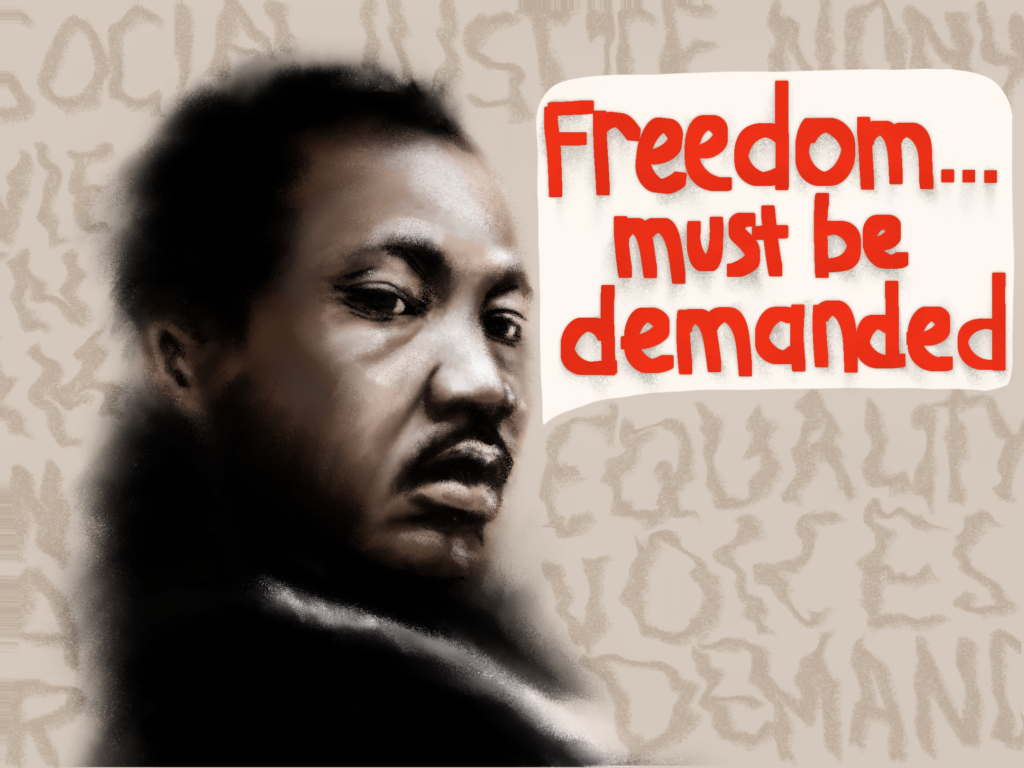
By Annabel Lee
Staff Writer
Martin Luther King Jr. is a highly regarded icon of the Civil Rights Movement. Many of us know King for his “I Have a Dream” speech or the three-day weekend we get in January. He is, more often than not, the first Civil Rights figure we learn about. Starting in elementary school, we fill in coloring pages of King’s photo and discuss the importance of peaceful protests. Yet, this singular focus paints a narrow idea of who MLK truly was.
In reality, MLK was a complex social justice activist and radical leader who fought for justice in all senses of the word. He believed that authority and legislation should be defied when morally wrong, an idea that many disagreed with. In his “Letters from a Birmingham Jail,” King notes that “freedom is never voluntarily given by the oppressor; it must be demanded by the oppressed” emphasizing the need for organized action and force to achieve justice.
Social justice is a complex, layered fight. King understood that to achieve true social justice, one needed to be involved with a multitude of contemporary issues. He notably spoke out against the Vietnam War and called for a minimum guaranteed income as a solution to poverty.
In a perfect world, peaceful protest works every time. People in power listen to those facing injustice and take their concerns into account to better the system for all. In a perfect world, the simple act of nonviolence is enough. But we are not living in that perfect world, in fact the reality we live in is far from perfect. King’s nonviolent campaign only achieved the success it did because he carefully crafted a plan of action.
King’s four step nonviolent campaign detailed collection of the injustices, negotiation, self-purification, and direct action. It required extensive step by step planning, with the ultimate goal of negotiation.
Self-purification essentially focused on the idea of nonviolence, and consisted of the emotional processing of injustice in an attempt to not act out in violence. Despite being faced with violence and hate crimes from the police and white neighbors, King argued that retaliating in violence would only further the cycle, ultimately not accomplishing the movement’s goals.
Instead, direct action gave the movement a symbolic voice, both to authorities and in the media. Direct action in the form of protests, sit-ins and boycotting, consisted of strategies to take economic power away from systems of oppression and bring attention to the issue. During the 1960s, the power of television in mainstream media became fully realized, and the strategy of nonviolence succeeded in reframing the narrative.
We often look at history with a hindsight bias, believing we would be on the morally right side of history if given the choice. MLK is no different. While the majority of current Americans agree with King’s efforts, that was not the case during his time. According to Gallup, in the 1960s, 63% of American adults viewed MLK unfavorably, with 44% saying he was highly unfavorable.
King’s ideology and fight seem straightforward to us now, yet history always appears more clear with time. Topics we now see as black and white were highly controversial in the past, similar to many issues we face today. However, instead of simply agreeing with already decided conflicts of the past, we must get involved with current issues.
Social justice, such as racial and economic equity, will always be controversial, so we should not avoid getting involved simply because something is complicated. Don’t be afraid to get involved in social and political issues just because they’re controversial, because everything MLK did was controversial at the time.
60 years from now, the complicated issues we currently face may become clearer. Be on the right side of history while there’s still time.
